#because it has to be as an aspect of the art and storytelling and the innate existence of theatre as a collaborative process
Explore tagged Tumblr posts
Text
Listening in on two guys talking about queer theatre (i think) and one is talking about a director he knows who hates the term queer because he still considers it purjorative and has no interest in reclaiming it and the guy here in the cafe said that he had forgotten there were people who were in that camp and how "you cant offend me because im more interested in learning" and its genuinely interesting to hear what ive only really heard in internet discourse in real life especially from a couple middle aged men in like a practical context
#the whole engage with the community in real life and not just online like#a) its true#b) theatre is one of the best subsections to angage with it in because its like an active conversation topic#because it has to be as an aspect of the art and storytelling and the innate existence of theatre as a collaborative process#'youre so wound up in your identity that youre not coherent' these guys are very interesting to listen in on
2 notes
·
View notes
Note
What do you think about Mumbo's art cam in the newer episodes?
I am personally still shocked like, HE CAN DO ART NOW? This man won't stop suprising me, I love it so much, also I don't see many people talking about that and I have no idea why because for me it's the best thing ever.
Anyways, hope you're doing good :D byee
the man does literally EVERYTHING.
when mumbo created @a.creative.junkyard for his art practice, only then I realized that he had literally been doing something like this for several years already. firstly for youtube, and after that he created many presentations of film projects to work with his clients, which already means a quite good basic skill in graphic design and especially the design eye.
still a big fan of his works from this account.
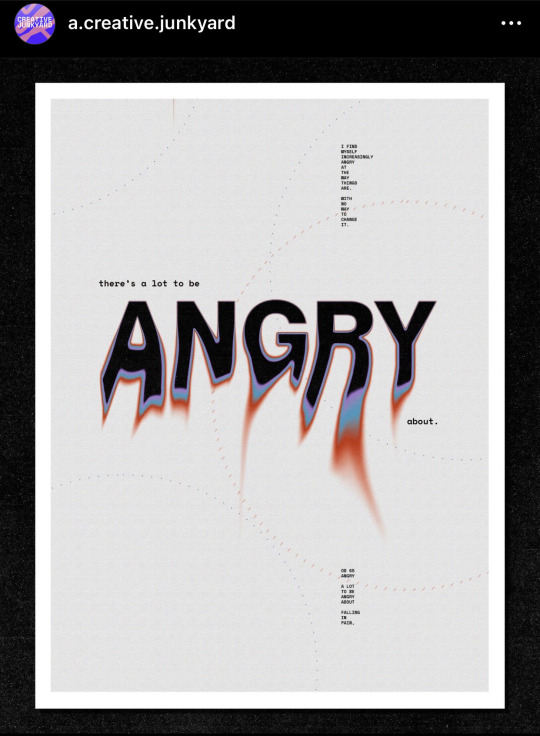
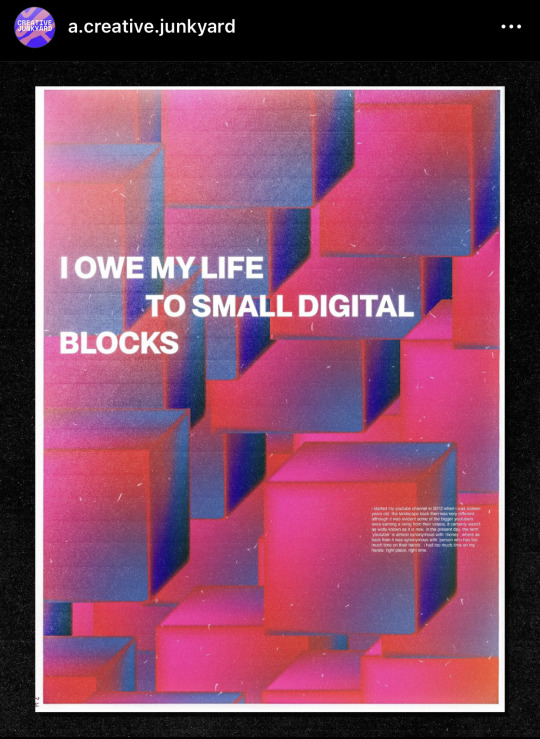
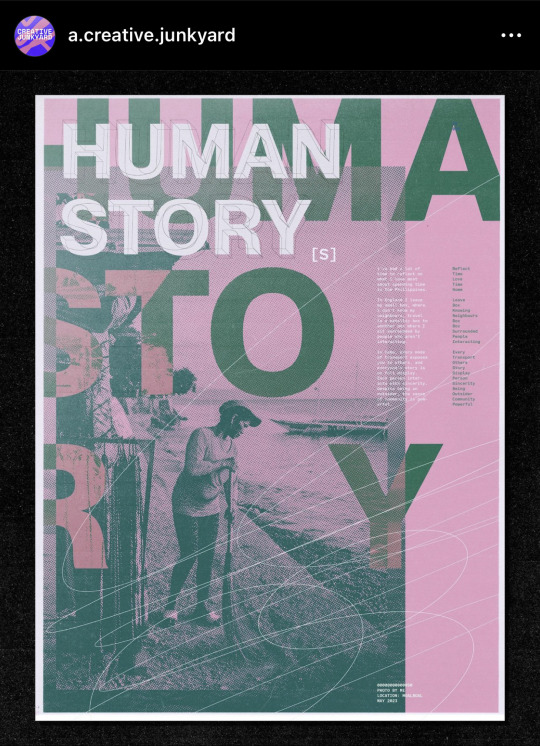
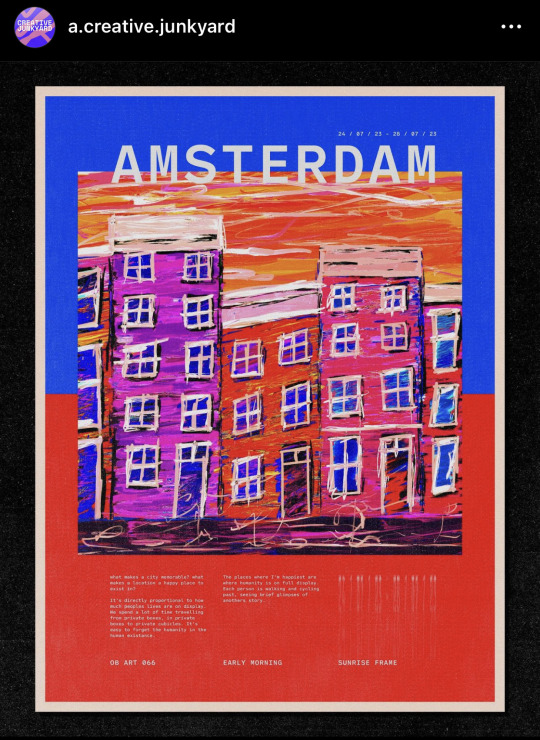
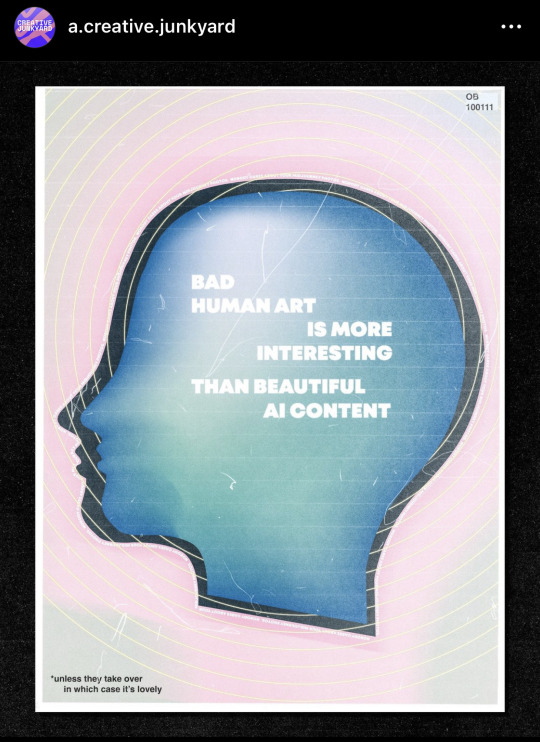

I love how he got creative with the start of season 10, using his skills to add some fun to the editing by creating new slides for his episodes. the way he’s sincerely passionate about creating such things, I empathically feel his joy.
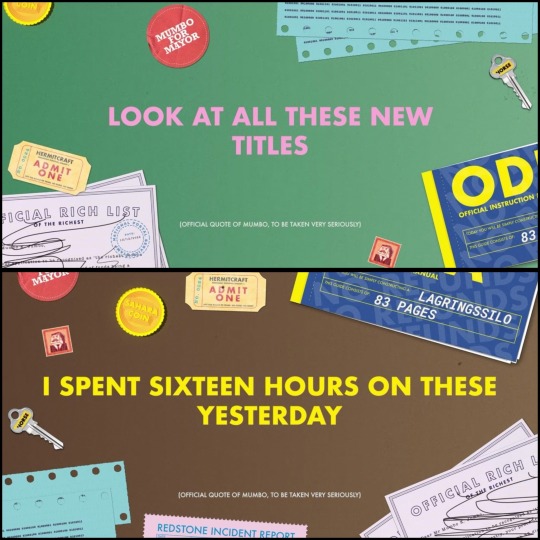

mumbo started visualizing the whole stories through what he creates, and all the effort, work and fun is absolutely worth it. he may have had some small storytelling pieces before, but now it has definitely moved to another level.
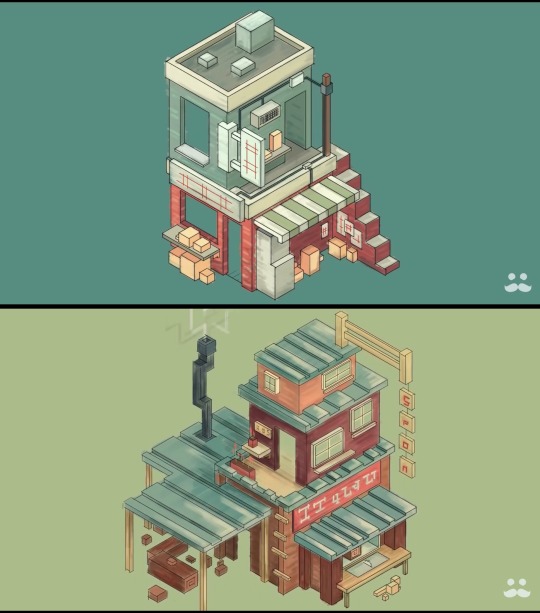
the hand drawn concepts. if you look closely at the video, he strokes the colors manually. mumbo gets so immersed in the process when drawing these concepts, it feels therapeutic even. I always liked to see the concepts of the other hermit’s bases, that they drew by hand. since my main hobby is drawing, it always brings me closer to people on some other level when I see their drawings. as a big fan of mumbo, I’m so infinitely happy that he started to show this part of the process too. these concepts always add even more to the result, I don’t know how to explain it in words. just more. more sense of life from a story, from a building itself.
mumbo has knowledge and experience, but it's like he's been focusing on other aspects while building on the server before. in season 9, he started moving in a different direction more, and now it has achieved clear visible progress, he’s more actively experimenting and isn’t afraid to take on something that he has never done. now mumbo is even more confidently saying that he’s proud of himself.
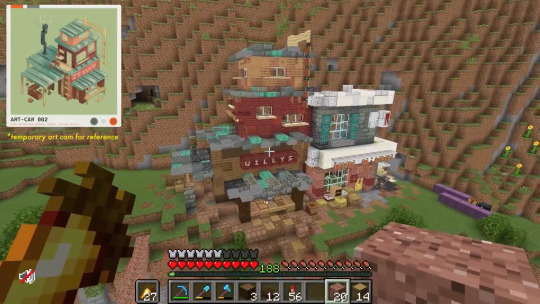
this may seem insignificant to an outsider viewer, but
for a man who has been building redstone stuff and solid giant symmetry for several years in a row, it’s mind blowing.
1K notes
·
View notes
Text
Thinking about how Click Clack technically knew that Thespius was in love with him, but also he didn't because he couldn't acknowledge it.
He has the power to say things that have happened or will come, but he can't do anything about it.
His narration is just that. Narration.
When you first meet him, he's gushes about how Thespius will be overjoyed at the fame he'll get him. Then he asks if you agree with this statement. If you shake your head "no" he responds with this narration:


"They know there's something deeper; something more important to Thespius's art--even if the God of Storytelling can't see it yet."
He knows "Oh Partner Mine!" isn't about fame. He knows that Thespius writes from the heart, but he also doesn't know. He narrates and narrates, but he can never actually respond to that narration. It's a quirk of his godhood. Of course the God of Storytelling speaks in stage directions and self-described dialogue, why wouldn't he?
This itself is just. so interesting to me. Imagine you can say things, but not actually say them. You have the power of all language within you, yet you can't even acknowledge your own narration.
This could imply that he's already confessed his feelings to Thespius before, but couldn't actually acknowledge it all because it was narration.
Like other aspects of godhood, the narration is a gift and a curse. Being able to take the world around him and describe it beautifully to a T, but unable hear his own words. Stuck behind a mask.
Anyway, I'm very normal about this game if you couldn't have a good day yall
#miles rambles#great god grove#great god grove spoilers#ggg spoilers#kind of but not really but also yeah#click clack#ggg click clack#thespius green#ggg thespius#thespius x click clack#ggglovestory#lovestory#character analysis#long post
515 notes
·
View notes
Text

"Why would you include those images in the book?"
In most sex scenes in Marvel comics - there is none [no sex], actually. You just see - oh, yeah, they wake up from the bed, and the deed has been done. This is one of the comics where we go into it as far as we can. So I think that's what made you think - you find it extremely steamy, or made you think "Oh we need to find a new writer, I'm going to go to your page and say the nastiest things," because of how far we go with it. But I think it's something that is necessary in this art form; we need to push things as far as we can. You wouldn't believe that a major X-Men event came out this same week because there were almost the same amount of discussions about this single page as much as there are on an X-Men event - a crossover event between two X-Men titles is having maybe even less discussion online than a single page from a Storm solo series. So that's the thing - we need to push the envelope. We've got to explore the different aspects of this character's life, [...] she's going to fight, she's going to do all that stuff, and sex is part of human life. It's part of the art form, it's part of storytelling.
- Murewa Ayodele, on why he included the Ororo/Logan scene, and its polarizing online response.
#ororo munroe#storm#comics#james logan howlett#wolverine#murewa ayodele#there's other things to focus on but I like his response here#especially to address how some fans don't like seeing the sex#very important message in an age where everything needs to be censored carte blanche#censorship
491 notes
·
View notes
Text
The Birth Chart of Japan 🇯🇵🌸




Japan Birth Chart Placements 🌌:
Rising in Virgo | Sun in Aries | Moon in Leo | Mercury in Taurus | Venus in Taurus | Mars in Cancer | Jupiter in Cancer | Saturn in Sagittarius | Uranus in Leo | Neptune in Libra | Pluto in Leo
Virgo Ascendant: One of the first impressions Japan receives is that it is a highly organized country with systems that can be considered complex because the systems are designed to be highly functional with a high degree of precision. This is evident in its well-structured government, efficient public services, and emphasis on order and discipline in daily life
Mercury & Venus in Taurus: Anime is known for its artistic beauty, deep storytelling & themes/characters that go beyond the surface. The Moon (the planet of feelings & emotions) feels exalted in the sign of Taurus, and Japan has their Venus in the sign of rulership, Taurus. Taurus is a sign associated with beauty & art. Many people watch anime in its original language, Japanese, as opposed to the dubbed-over version in their own language. Many people find the Japanese language aesthetically pleasing (Mercury in Taurus is known for having an aesthetically pleasing talking voice)
Jupiter & Mars in Cancer: Japan is generally considered a family-oriented country, with a strong emphasis on family values and tradition, and deep respect for elders is a strong foundational principle taught from a young age in Japan. Cancer is connected to ancestors, and Japan has significant practices for ancestor worship; this fosters a strong connection to present and past generations (Cancer also rules over nostalgia). Jupiter represents our values on a deep, spiritual level, and Mars represents what we exert a lot of energy towards
2nd House in Libra: Japanese culture is generally known for its emphasis on harmony, respect, & politeness, and the 2nd house represents our skills, what we value, & our habits
Uranus 15° & Pluto 13° in Leo: Japan is ranked 13th globally in innovation and is considered a technologically advanced country. Whatever planet is sitting in the sign of Leo can represent where we are naturally talented and can be one of the "main ideas." Uranus rules over innovation, technology, & the future, whereas Pluto represents power
North Node in Libra & South Node in Aries: The South Node in Aries shows off how Japan in history has had fierce troops, been extremely strategic in military, & beat up countries way larger than them (Russia & China). Interestingly enough, the North Node in Libra can also show how Japan eventually surrendered the last time it was at war
PT 2: Libra rules over popularity, art, food & aesthetics; it doesn't surprise me that Japan created new laws due to the rise of popularity and surge of tourists (this happened when Japan had its nodal opposition from 2023-2024)
9th house in Taurus: Since the 9th house represents culture/religion, I'm using this house to interpret what the culture/main religions of the country are like. Taurus is the sign that is associated with the present moment & nature. Shinto (the largest religion in Japan) is a religion that focuses on harmony with nature & the present moment
Saturn trine Sun, Uranus & Pluto | Saturn sextile Neptune: Saturn is aspecting 7 different parts of the chart, mostly well-aspected at that. Saturn, seen so heavily throughout Japan's chart, explains why Japan values structure, longevity, systems that work, harmony, respect, politeness, taking responsibility for the good of its citizens, tradition, and the blend of ancient and modern influences
#astrology#astrology notes#astro tumblr#japan#astrology aspects#astrology observations#astro community#birth chart#astrology blog
184 notes
·
View notes
Text
Imagine how much Shen Yuan and Airplane would hate it if an actual PIDW fan transmigrated in too, though.
Like, one of the guys who genuinely loved the stallion novel harem-building aspects, the weird-yet-vanilla het sex, the willingness to throw the plot out of the door just to have yet another interchangeable woman throw herself at the hero. Someone who only ever had nice things to say in the comment section, who unironically referred to Airplane as a master storyteller, who bought some of the VIP chapters (if he liked the wife Bingge was destined to wed & bed), couldn't name any of the monsters or sex flowers or most of the male side characters, had a Xin Mo keychain and once commissioned fan art of Sha Hualing (favorite wife) looking sexy in a pin-up pose, and told Peerless Cucumber he was a weirdo who took things too seriously on more than one occasion.
I think he'd bother Airplane the most. Shen Yuan would be annoyed and tell him his taste was in his ass, but that's about it.
But Airplane? I think at first he'd be inclined to enjoy having an uncomplicated "fan" of his work turn up. This guy actually praises him! He has nothing but flattering things to say! It's like a dream come true! Except... well, Airplane himself is perfectly aware of the decisions he made in his writing and why (he sold out deliberately, not because he thought it would actually make for a better story -- say what you will about whether or not it's worth it, but the man knows what he's doing), and also I suspect kind of resents his own popular audience whenever he has to interact with them for more than minute.
After all, these were the patrons he had to appease and appeal to, the readers he had to worry about offending or alienating, the ones who were paying the bills but also would have vanished at the drop of a hat if he hadn't given them a steady supply of what they wanted. It's not the audience he actually desired, it's the one he decided not to offend in order to maximize profitability. Peerless Cucumber might be a pain in the ass, but he's a pain in the ass who picked up on the story that Airplane himself originally intended to tell, and wanted PIDW to actually be that. Which has gotta be kind of gratifying, in a roundabout way.
I think it would stress Airplane out to have someone approve of the things he himself didn't even approve of. Like on the one hand this guy seems to have only a good opinion of him, but on the other hand it's based entirely on a false impression and Airplane actually agrees way more with Cucumber's assessment of his writing, because he wrote it badly on purpose. Since the guy has a good opinion, that's something Airplane can potentially lose, and he'd be most likely to lose it by revealing the truth about his own creative intentions and his actual tastes and inclinations. A ticking time bomb of disapproval that could go off at any moment to who-knows-what effect.
He'd hate it. Eventually every time User No.3 came around he'd just be like:
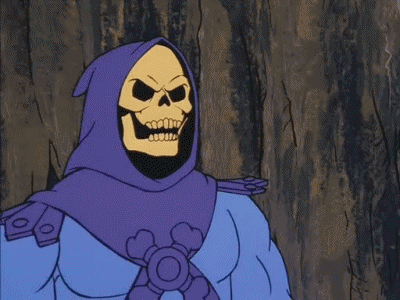
[ID: A gif of Skeletor from Masters of the Universe gliding through a blue magical barrier and then reaching back to punch and shatter it. End ID]
#svsss#scum villain's self saving system#scum villain#airplane: finally a REAL fan#airplane five minutes later: hmm... don't like this#image ID provided by princess-of-purple-prose
1K notes
·
View notes
Note
hi!! I absolutely adore your artstyle SO MUCH!! The sharp and confident line art compliments your clear storytelling skills, I love it.
Anyways, i thought it'd be fun to ask why you ship spideypool & what aspects about their dynamic intrigue you the most? 🫶
I’ve already touched on this here but I could honestly ramble on for days about why I ship it so much hahaha.
Some reasons are personal but what I will say, I really like their similarities and contrasts, and how they fit with each other?
They’re both mutates, but oddly are also linked to in-universe cosmic entities (Death and Life/Destiny);
They’re also both considered the “clowns” of Marvel because of their humor and playful personalities, and even their costumes are similiar.
At the same time they’re opposites in how they operate, Wade being an assassin/anti-hero and Peter a protector of ALL life: you’d think this would put them at odds and you’d be right, except for an old, cursed comic run called Spider-Man/Deadpool.

Now, I don’t claim to know what went on with Marvel execs when they approved this comic, but it's NOT amazing.
Sure, it’s quite funny and it has some touching moments, but overall it feels like a forced attempt to make these two character become friends.
The development of their friendship feels rushed, almost out of nowhere at points… which gives the involuntary impression that despite their overwhelming differences, these two just cannot stay away from each other. Like. It goes a little beyond bromantic.

These panels happen right after Deadpool kills Peter twice (It was a misunderstanding, he brings him back! But still). Spider-Man, famously a lone-wolf in his comics, not only forgives him the next issue, but also brings him along for missions and then says stuff like this to him.
And why does Wade look like that? Because according to this comic, DP’s appearance is solely caused by his self-esteem, and Peter makes him feel so good about himself that his healing factor finally fixes his face.
Preposterous stuff. You could say bad writing… Or, you could be whimsical about it and say this is happening because they’re actually soulmates.
Oh, nevermind! The comic does that for you.

Canon aside, their differences actually complement each other so well.
Wade, who is numb to killing and death, needs someone like Peter to remind him of life’s value,
Peter, who is haunted by loss, would find solace in loving someone who can’t die.
I could go on. But I'd rather do that with ART
#Thank you so much!!! I'm so happy you like my silly artstyle#And just to clarify I only ship/draw their Comic versions#spideypool#ask#deadpool#spiderman#long post
278 notes
·
View notes
Text
Our fourth edition of the Black History Month Author Spotlight series, features Becky (@losergames)!

(I’ve been in awe of Becky’s multi-talents (art, writing, coding, excuse me??) for a long time now, and am super excited to get to interview her and introduce her awesome game, Chop Shop! The portion on morality and finding a middle-ground between harmful stereotypes of “bad” POC characters and angelic, one-dimensional ones who can do no wrong was a really interesting and insightful take.)
Author: Becky
Hello hello!!! I’m Becky! I am a black bisexual woman from the UK, lover of games, TV and food. I have a Bachelor's degree in Animation & Visual Effects and currently work as a technician at a college 😁
Games: Chop Shop (crime, action, LGBTQ+, meaningful choices)

Short blurb: A crime action interactive fiction game.
Quote from the interview
There are a few main themes I keep in mind about when writing Chop Shop but the big one I think everyone understands is morality. What is right and wrong, and the various shades of grey in between, has been written about a thousand times in a thousand ways but it is continuously interesting to me in a changing world. What does it mean to be a bad person doing good things and a good person doing bad things? Is there a chance for redemption? What are the consequences? Race and class are also massive factors, made all the more complicated when we’re looking at sets of characters on either side of the PC’s life. I want to write black and other characters of colour make bad, questionable, and unredeemable decisions whilst also remaining aware of stereotypes and archetypes. I want them to be loud, messy, and rude, attributes that are always attached to minorities, but I also want them to be smart, calculating, and deceptive. I think a lot of people are scared to do so and we end up with plain, can-do-no-wrongers that lack any depth.
Read on for the full interview!
Can you tell me a bit about what you’re working on right now and your journey into interactive fiction? What inspired the game/story you’re currently writing?
I am currently working on the crime action interactive fiction Chop Shop. There are a mix of inspirations that went into Chop Shop but above all else I’d say the kicker was my circumstances at the time.
During covid I walked away from the WORST job I’ve ever had and moved back home, which I realised a while after was an extremely huge blessing. I had a major burnout and was processing what my ex-managers had put me and my colleagues through. So, in my freetime I was playing a lot of cyoa/ romance games (shoutout Love Island the game) and found a whole fandom that also enjoyed them.
I made some friends, did art commissions, and wrote some fanfic here and there, yadda yadda. A close friend recommended I try out a very popular COG game at the time (🧛) and it all spiraled from there. I fell in love with the format, endless creativity, and community and never looked back.
I loved the Need For Speed games as a kid, the og Most Wanted, Carbon, and Underground 2 are, in my eyes, amongst the masterpieces of games from the 2000s. It got to the point I was going over to friends houses just to play on their PS2 lmao. I am also a Fast and Furious fiend (shock) and I will defend that god awful series till I die. Fast forward to being a teenager/ young adult I’ve become a massive fan of fictional crime shows. Breaking Bad will always be my first love, but I also love The Sopranos, Fargo, The Wire and more.
How has your identity, heritage/background, upbringing, or personal experiences influenced your storytelling or writing process? OR How does your work feature aspects of your identity / experience?
The real catalyst for Chop Shop was my previous job. A lot of the PC’s experiences are based off my own. A few examples I love sharing are how I had to make breakfast for my boss every morning and had to keep the office freezer stocked with a specific supermarket ice lolly because he ‘needed’ one every day at 3pm. I truly wish I was making this up because people think I’m crazy when I tell them. But I really was catering to a man-child because I was desperately trying to get my foot into a creative industry. Woof!!!
That said, the industry I wanted to work in was and still is extremely competitive. I came out of uni with a tonne of friends, but also a tonne of competition. It stung very badly to see my peers excel and surpass me when it came to careers but that’s just a part of becoming an adult. That life really was not for me and I’m glad I’m out of it now.
My mother is an extremely influential person in my life. Bits and pieces of her stick with me, not just in my writing but my every day. She’s worked in corporate all her life, from the early 80s and still to this day. She laughs about it now but she tells stories about the times she was laughed out of meetings or undermined by subordinates because she was a black woman in positions that were not occupied by minorities. It hurts to think about but I can only dream of having the type of strength she does.
Now that I think about it, Chop Shop is a massive fuck you to the past.
Are there any specific themes or messages you hope players take away from your work?
There are a few main themes I keep in mind about when writing Chop Shop but the big one I think everyone understands is morality. What is right and wrong, and the various shades of grey in between, has been written about a thousand times in a thousand ways but it is continuously interesting to me in a changing world. What does it mean to be a bad person doing good things and a good person doing bad things? Is there a chance for redemption? What are the consequences?
Race and class are also massive factors, made all the more complicated when we’re looking at sets of characters on either side of the PC’s life. I want to write black and other characters of colour make bad, questionable, and unredeemable decisions whilst also remaining aware of stereotypes and archetypes. I want them to be loud, messy, and rude, attributes that are always attached to minorities, but I also want them to be smart, calculating, and deceptive. I think a lot of people are scared to do so and we end up with plain, can-do-no-wrongers that lack any depth.
What does your writing process look like? Any rituals or habits? Any tips, tricks, philosophies or approaches that have worked very well for you?
I write way better outside of my bedroom. I know writing is supposed to be fun and a hobby but sometimes it’s… not. If I get stressed out in my room, it’s all a mess. The brain needs to be away from where I sleep to get work done. Last summer, when all the teachers were on holiday time, I was the only one in my department for weeks and it was the best writing stint I ever had haha.
Oh and I keep a huge spreadsheet. All the episode breakdowns, outlines, character details etc. It looks insane to anyone else but it is my prized baby.
Do you have favourite interactive fiction games, characters, scenes or authors that you’d like to recommend?
My goto game rec is always 180 Files: The Aegis Project. So quick and punchy, more narrative/plot than romance focused. The action sequences are fun and the interactions are so delicious, ugh. I love it. I’ve played it at least 20 times to get the different endings and it’s never not satisfying, just… chefs kiss. I’m also really enjoying Thicker Than right now AAHHH I NEED TO CATCH UP!!!
Any books, music, movies etc. you’re obsessed with at the moment, or which changed your life (or perspectives on something)?
Not anything specific but I do have some books I’d like to recommend to my fellow black readers:
The Psychosis of Whiteness: Surviving the Insanity of a Racist World by Nicola Rollock
Black Skin, White Masks by Franz Fanon
The Strangers: Five Extraordinary Black Men and the Worlds That Made Them by Ekow Eshun
Black England: A Forgotten Georgian History by Gretchen Gerzina
The Hard Road To Renewal by Stuart Hall
Honestly I’d recommend anything by Stuart Hall lmao. RIP king, you would be shocked at the media literacy today.
This-or-that segment: (bold = Becky's pick)
Coffee or tea?
Early mornings or late nights?
City or countryside?
Angsty or Cozy romances? (Or enemies-to-lovers or best-friends-to-lovers?)
Steady progress or frenzied binge-writing followed by periods of calm?
Summer or Winter?
First drafts or editing?
Introvert or extrovert?
Plotter or pantser?
Characters or plot first?
Becky’s custom “either-or” pairing: Driver or passenger?
#chop shop if#interactive fiction#if#author spotlight#black history month#interview feature#interact-if
208 notes
·
View notes
Text
My dear lgbt+ kids,
Let’s look at some myths and facts about drag queens:
Myth: “Drag queen” is a gender identity.
Fact: Drag is a performance art.
Let’s go into some detail here: “Drag queen” is a role you play, for example as a form of entertainment or as an expression of your creativity. A gender identity on the other hand is intrinsic and enduring, it’s about who you are in your mind and heart (For example: a trans woman doesn’t “play” a woman, she IS a woman). So, drag and gender identity are two separate things - although we also need to add a little disclaimer here that gender identity is wonderfully complex and highly individual and not always so easily defined. So while drag is usually separate from gender identity, there can be overlap!
Myth: All drag queens are gay cis men.
Fact: Drag is an inclusive art form. Many drag queens are gay cis men, but not all. Drag performers can have any sexual orientation and gender identity - including transgender or non-binary. See that part about “overlap” above!
Myth: There’s only one type of drag.
Fact: Drag is incredibly diverse and has many different styles. Drag queens may also blend different types to create their own unique persona. Some examples: Pageant drag focuses on glamour and beauty (drawing inspiration from traditional beauty pageants). Camp drag leans into humor and exaggeration (celebrating the “so bad it's good” aesthetic). Alternative drag experiments with unconventional or avant-garde looks (breaking norms to challenge mainstream beauty standards). Club kid drag is known for its bold, futuristic looks (inspired by the nightlife scenes of the 80s and 90s).
Myth: Drag is inherently sexual.
Fact: Any art form can potentially be done in a sexual way but that doesn’t mean art is an inherently sexual thing. So, while some drag performances may include adult humor or themes (if they’re advertised for an adult audience), many other shows are family-friendly and focus on comedy, storytelling, or artistry. A drag event advertised as a family event will not be sexual. (It’s really just a common sense thing: You don’t expect kids movies to be sexual, just because adult movies also exist).
Myth: Drag has only been around for a few years.
Fact: Drag has a long history, dating back centuries. Men and women have cross-dressed in theater since at least the time of Shakespeare, and modern drag has roots in the ballroom culture of the 20th century. It definitely didn’t randomly spring up in the 2020s.
Myth: Drag queens make fun of women.
Fact: It’s more the opposite. Drag is a tribute to femininity and celebrates aspects of female identity and fashion. While some drag may use exaggerated features for humor, it’s usually done with admiration and respect, not as mockery. If it mocks something, it’s usually things like extreme beauty standards, gender stereotypes etc.
Myth: All drag queens are famous and rich. It’s easy money.
Fact: The majority of drag performers are local artists who put a lot of time, effort, and money into their craft without making much. Only a small fraction gain fame or wealth, most do it out of passion.
Myth: Drag isn’t important for the lgbt+ movement. A ban on drag doesn’t really affect the community.
Fact: Drag historically has been (and still is) an essential part of the lgbt+ movement, creating a visible platform for self-expression and providing a safe space where people can explore their identities. Drag performers have often led the way in activism, supporting many causes from HIV/AIDS awareness to transgender rights. A ban on drag doesn’t just limit artistic freedom - it threatens to silence a key part of queer culture and history. It also sets a dangerous precedent that can lead to further restrictions on our rights, marking the start of a slippery slope toward broader discrimination.
With all my love,
Your Tumblr Dad
267 notes
·
View notes
Text
△◬▲ Avengers' Hobbies ▲◬△
Here are some hobbies and interests that I think the Avengers will have when I shift, including my own that I already have here. I will probably update this when I shift and we'll see if I'm right! Some of these are canon, but I'm throwing them in here for fun anyway.
△◬▲◬△
▲ Tony
△ Rubik's cube (and other little puzzles) - That brain of his must have mastered it in a day, so he probably does it mindlessly while he thinks.
△ Formula 1 - As seen in the MCU. But it's SO fitting for him, I just have to put that out there.
△ Concerts - He loves a good party and, based on his t-shirts, he seems to love music. I wouldn't be surprised if he just hangs out on the side of the stages because he's Tony Stark and can.
△ Design - He's made quite a few suits, so I can see him really getting into the creative aspect of things. This applies to all of his inventions too. They have to look as "cool" as he does, right?
▲ Rhodey
△ Reading - Give this man a newspaper or a biography or something, he'll be set.
△ Pool & Ping Pong - Somehow, someway, he's just way better at both of these than 94% of the population. And yes, he will definitely rub it in your face.
△ Piano - I feel like his mother or grandmother taught him how to play when he was young so it's a very sentimental talent of his.
▲ Peter
△ Photography - Obviously. That little stinker is too talented for his own good.
△ Tinkering in the Lab - Based on his enthusiasm in the MCU, I think he spends a lot of his time just messing around in the lab, even if he's alone, though of course he prefers to have company. He gets so excited when an idea of his works.
△ Quality Time - Like I mentioned, he likes company. He might be a little awkward sometimes, but I think that's what makes that time with people mean so much to him. It makes him happy to know that people want to hang out with him.
△ Slacklining - Hear me out. He uses his webs to create a makeshift slackline across buildings or whatever. Maybe he's on a stakeout and gets bored, I don't know, but he's damn good at it.
▲ Bruce
△ The Opera - As we saw in the MCU, he uses music to calm himself down. But I think he has a deeper connection and fascination with it than most may notice. There's something about the harmony between all of the instruments and voices that mesmerizes him. He could go on and on about it, and I can't wait to listen to him rant when I shift!
△ Scientific Research - If he's not the one doing the research, then he's reading all about it. He loves hearing other people's discoveries and he craves getting all the knowledge he can.
△ Meditation - With all of the Hulk nonsense, he got into it to help his anger. Maybe it works sometimes and doesn't other times. I don't know, but I think he has grown to love the process.
▲ Thor
△ History & Storytelling - As we know, he loves sharing stories of his own, but I think he also enjoys hearing them from others. He might one up them afterwards... Still, though. He really likes learning about makes people and places the way they are: their history and experiences.
△ Tests of Physical Strength - He has strength, a lot of it, and he likes to show it. He loves competitions between the Avengers (and winning). Even tug of war, he'll be there.
△ Singing - He sings in the shower. There's no way he doesn't. And he's actually quite good. For some reason, I feel like he might not do it in public much (unless he's drunk or joking around). Maybe it's an Asgardian culture thing.
▲ Scott
△ Scott is just excessively talented for no reason. He can learn any skill. It's actually kind infuriating. Anyway, I'll list a few.
△ Magic, Drums, Arts and Crafts, Card Games, Juggling, etc...
▲ Pietro
△ Sports - He's ridiculously athletic. He has mastered every sport. He probably doesn't even need his powers to be good at them. He's just a boss man like that. I do think his specialty is soccer (football, I know; I'm American, I'm sorry), as in I think he probably played it as a child and was obviously the best.
△ Wii Sports - He's unstoppable. No one can beat him. He has set impossibly high records. Still, he loves playing them so much.
△ Just Dance - Yeah, it's the same situation as the Wii. Those hips don't lie. Unfortunately, this means that it's very hard to convince people to play with him. He happily plays by himself, but of course it's more fun with other people.
▲ Wanda
△ Cooking - As seen in the MCU, but I'm so excited to taste her creations, are you kidding? I bet she finds all sorts of cute recipes on Pinterest too.
△ Ukulele - I remember seeing a guitar in her room in the Compound (Civil War I think?), but I think she started with a little ukulele! Maybe her parents bought her one for her birthday and she was devastated that she lost it during the incident we shall not name. She's such a sweetheart, I can't.
△ Crochet - She could probably crochet using her powers with her eyes closed. I also think she likes doing it to practice her control of her powers for precision purposes.
△ Jigsaw Puzzles - Just like I previously mentioned, I think she enjoys it for practicing her powers, but I also think she likes the peacefulness of it.
▲ Clint
△ Pool - Remember when I said that Rhodey is better at pool than 94% of the population? Yeah, Clint is the one person he can't beat. His aim is unearthly.
△ Harmonica - This guy will whip out a harmonica out of nowhere (one of his many pockets) and give the crew a nice little tune. He's quite skilled too. Name any song and he'll learn it for you in an hour.
△ Card Games - He may act nonchalant or like he doesn't really care about the game, but he will turn around and win with one incredible move and blow everyone's minds, then shrug like it was nothing. That brain is bigger than we give him credit for, I'm calling it right now.
△ Surfing - He just has that vibe. Not the stereotypical surfer dude, but a guy who will casually surf a forty-foot wave after he finishes a mission in Fiji or something. He's cool like that.
▲ Nat
△ Ballet - Despite all the trauma associated with it, I think she still has a soft spot for dancing. It was such a major part of her life for so long, so maybe she does it to heal her inner child.
△ Yoga - She has to stay flexible somehow, right? Also, I think she'd enjoy doing it to calm down after a mission or when she's stressed.
△ Aerial Silks - Speaking of flexibility... Same goes for this! She does all sorts of cool tricks too.
△ Hair - Her hairstyle changed like every movie, who has time to go to a hairdresser when you're a super spy? That lovely lady learned to cut and dye it herself, and I'm sure she'd happily do it for others if they ask. (*Nat and Steve will be together in my DR and I bet she cuts his every time!)
▲ Steve
△ Drawing - As seen in the MCU. He definitely doodles during meetings.
△ Calligraphy - Writing in cursive was way more common and just what everyone did. So, due to his physical limitations, I think he probably spent a lot of time practicing his penmanship and perfecting its art form, especially while he was sick. Drawing and writing were two of his major pastimes.
△ Running - Since he kind of couldn't, or rather, couldn't to the average extent or the extent he wanted to, he takes advantage of his abilities now. He loves the rush too. Can't relate, but go you, Steve!
△ Museums - He likes catching up on what he missed, but also enjoys the stories the world holds. He has always like history, so learning everything about the past seventy years and the rest of time keeps him busy.
▲ Sam
△ Cooking - As seen in TFATWS. But I also think he loves food and is totally a food critic, so obviously he wants to have the best cuisine on deck whenever he wants.
△ Psychology - Since he was a counselor for veterans, I think psychology interests him a lot more than some think. He may be a goof, but there's some wisdom inside him too.
△ Chatting - It's his favorite thing to do. He could talk for days straight. He loves it so, so much.
△ Board Games - He might get a little distracted during card games, thanks to the chatting, but if a board game is pulled out, he is completely invested. There's something about the map-like structure that makes his brain spark.
▲ Bucky
△ Reading - As seen in TFATWS. He loves a good fantasy book to take his mind to a different, sometimes better place.
△ Welding - He would be so good at this. I don't he did this exactly on Sam's parents' boat, but I'm sure he has the mechanical experience.
△ Repairs - As seen in TFATWS. I think he really likes fixing things, having the control to make something right and doing it, even if it's something small like a leaking faucet. It makes him feel helpful.
△ Gardening - Hear me out, stay with me. Imagine how much love and effort he would put into a couple plants, even if they're just houseplants. That nurturing side of him that he showed to Steve in the forties must still be in there. He wants to nurture something (and someone, aka me lol) in the way no one did for him when he was a slave for HYDRA. And once he masters it, he's damn good at it.
△ Games - As seen in TFATWS. There's playfulness in him past the brooding.
▲ Me
△ Abstract painting - I've been painting for a few years now and I love it! I just play some music and zone out, letting the paint take me away... I'm excited to make some art for people's birthdays and whatnot when I shift, just like I do here!
△ Baking - I definitely prefer baking over cooking. Give me a recipe and I can make anything. Plus, I have a major sweet tooth. My CR mom tells me that baking is my love language and she's not wrong.
△ Writing - Creative writing is my passion! I have so many possible book ideas, we'll see if I actually write any of them someday. I certainly want to!
#shiftblr#shifting community#shifting#shifting blog#shifting motivation#reality shifting#reality shifter#shifting realities#marvel dr#shifter#mcu dr#mcu desired reality#mcu reality shifting#mcu shifting#mcu headcanons#marvel reality shfiting#marvel headcanons#avengers headcanons#marvel shifting#marvel desired reality#marvel#shifters#desired reality
101 notes
·
View notes
Note
Hi Volta! What are your top ten fic recs (any ship, any length) ?
Dude I have so many recommendations of fics that have like… changed my life. Like it’s dramatic but I reread them and I get filled with so much nostalgia and love for them- sometimes the second read is better than the first and you spot the details of characterisation and easter eggs!! So allow me to just ramble my appreciations for these fics (I go on tangents a lot whoops)
So I feel I must mention this first but
1) Bloodlust - Libbywednesday
This fic got me back into the fandom when I saw the animatic on youtube!! I was hooked and read it in a day. I loved the grittiness and the slow burn aspect of it, the characterisations were also amazing!
2) The Thief Trilogy - Wintergrew
I read this fic straight after I completed Stick of Truth!!! MY GOD… it’s amazing. It’s a favourite Creek fic of mine but it wasn’t just the romance, it was the action and the amount of world building that went into it that truly made it spellbinding. I read it in like five days and it has one of my favourite characterisations of Tweek to be honest!!! This fic was also what made me get an ao3 account.
3) Stan Marsh and the Lost Lyre - Alottodix
Okay- this was the first fic I read when I got an ao3 account and I am in love with it!!! I may not have read Percy Jackson or know much about it but this fic made me WISH I did. It’s amazing, the narration, storytelling and the characters are so well written and it brings me so many feelings of how it felt when I first read fantasy as a kid!! Like it’s just so cosy and the found family dynamic is just SO good. Also @alottodix has the best characterisation of Cartman, rereading passages gave me a deeper appreciation!!
4) Chaos Plan - Helioleti
THIS FIC MADE ME CRY. BAWL. SOB. Like I was crying at 2am even though I had a shift next morning LMAO. This is such a good fic, it’s quite dark with themes and it reads like a suspense/mystery. It reminds me a lot of the film ‘Brick’ with Joseph Gordon-Levitt and I love that aspect of it- solving the mystery and the characterisation of Kenny is so fucking amazing. I highly recommend reading the Chaos Plan extra - I read it because I needed more Chaos Plan content and it was so worth it.
5) I Will Make of You - Purplepeptobeismol
This fic also made me cry- but happy tears this time lmao. As you can tell I’m just very emotional. This fic is one of the best for original character at the centre but still weaving it into canon- I LOVE COOPER MCCORMICK!! Reading this was a blast and I loved the amount of research that went to it such as time travel and all that (I’m not gonna spoil the rest but just AAAA) it’s so good and the writing is so good and I found myself emotionally invested.
6) Top 3 reasons to not open a multidimensional time rift: number one will surprise you - Clearly_Nonsense
THIS FIC IS SO GOOD!!! It has the zaniness of South Park and it’s done so well, I found myself laughing out loud at some passages!! I loved the multidimensional aspect and how characters from FBW/SOT/SP would interact in these different settings. I also love Tool Shed <3 he’s my favourite character in this fic (Brazilian Tool Shed FOR LIFE) !!! I also need to mention the art work that’s in the fic is AMAZING- it captures the scenes so well. It’s so good and y’all should follow @up-side-in-side-out for their art!!
7) The Gods Watched Over Us - Ursamajorstories
AAAA if you love Atlantis and Road to El Dorado this fic is for you!! It has incan Craig/explorer Tweek and it’s so good. I loved the characterisations and the writing was IMPECCABLE. Like it was so vivid with imagery and it’s like a comfort read honestly. I also loved the world building as well and it was another fic I read when I first got my ao3 account!!!
8) Groomsmen - Apricotkittycat
I LOVE THIS FIC!!! I love their take on style in this fic and Stan and Wendy’s friendship <3 I also love Ike and Marjorine in it too. The concept is kind of like Slice of Life-ish but then BAM there’s a whole mystery to solve. It’s a great spin on things. The narrative is great and I love so many scenes that I can’t say for fear of spoiling but I highly recommend it- I read it in a day!!
9) The Perks of Being an Eldritch Abomination - PheonixKenny
I know I mentioned it earlier but this fic is AMAZING!! I LOVE cthulhu Kenny and this fic did so much effort with the body horror aspect of his curse taking on physical form - also there’s a lot of comfort so it’s really sweet and I loved the friendship dynamics. Really good- I love it!!
10) I saw the Stars in Your Tail - Craigtuckeradvocate
I will always love this fic. I read it when I was 12 or 13 and it has such a special place in my heart (I’m also a sucker for mermaid AUS.) THIS WAS AMAZING - I loved the romance between Craig and Tweek and it’s stays with me ever since. I’ll probably cry reading it because of nostalgia and how long time has passed. <3
Sorry this took forever but here are fics I LOVE and am obsessed with forever <33
#south park#kenny mccormick#stan marsh#kyle broflovski#eric cartman#butters stotch#craig tucker#south park au#south park fanfiction#fic recs
82 notes
·
View notes
Text
DBDA Character Appreciation Week: #4 Niko Sasaki
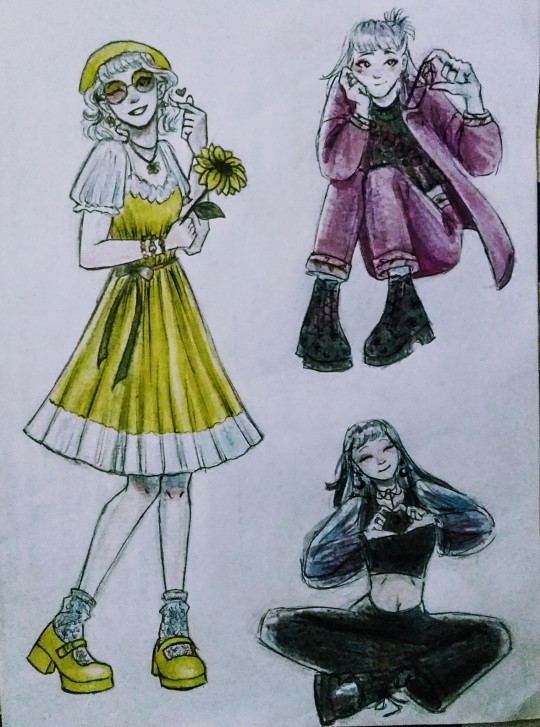

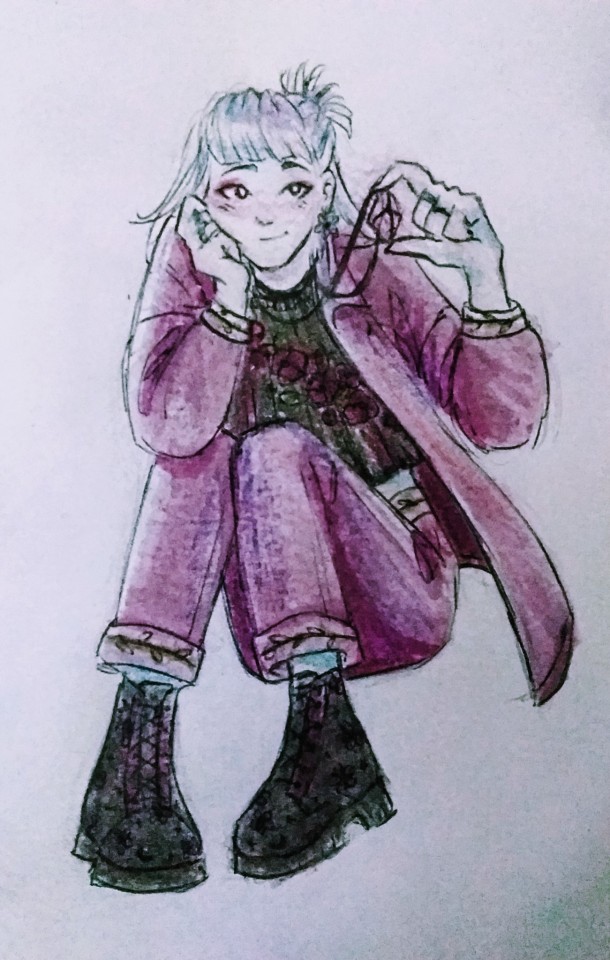

I love her sm!!! Outfit ideas here by @katygorl
The yellow one is w a pastel highlighter, and the other two w colouring pencils and greyish purple and violet highlighter. I really like this one, I think I'm starting to find a colouring technique I don't completely hate!!! Whoohoo! (Btw in the purple one, the flowers on her top and boots are two different types of Violets, and she's holding a pink sea glass bc palasaki my beloved ones, they're matching ✨✨✨).
Words can't explain how much I love Niko, she's incredibly sweet and friendly and empathetic, and I love her dynamic with practically every character in the show, but what I love the most is that we can actually see on-screen how much she grows through the chapters, how stronger she's getting. I love DBDA because it portrays how different people deals with their feelings in a realistic way, how every teen has their own problems and it takes them with the care it deserves, it doesn't feel exaggerated but every topic is given the adequate seriousness it requires, and honestly is such a masterpiece in the storytelling and pacing through the chapters between the cases and their own character arcs that their evolution doesn't feel rushed at all, but then you look back and see how much they changed, and is really heartwarming.
I love Niko because at first she's locked up in her room and doesn't talk with anyone, and slowly starts opening up with Crystal, and the boys, and then you think she's okay, but she's not. Dealing with depression and mental health issues it's much more difficult than it might seem from the outside, because one day you're feeling Good Enough to go and talk to people with a smile on the face, but that doesn't mean you're really okay. That just means you're feeling Good Enough to keep the mask on through a conversation. And Niko feels pretty realistic and natural to me because healing requires time, and support, and the agency is supporting her but they're not rushing her up to join on cases until she's ready, and that's beautiful. I think it's beautiful bc it shows a healthy environment that provides comfort and support and she's getting better thanks to it, and thanks her own hidden strength, and they're helping her realize where that strength comes from.
And, idk, as I have already said millions of times, I really love Niko and Edwin's relationship, it feels so genuine and heartwarming and bro I want the Niko to my Edwin soooo bad. Help. But my point is. I think the best word I could find to describe their relationship is "comfort" bc they can be themselves with each other, talk about their problems without pressure, knowing that the other will accept them no matter what and will help and support them and, idk, the scene when they're watching Scooby Doo while Niko writers the letter to her mother and Edwin is just there, not intervening but just saying there so she's not alone, idk, it spokes so deeply to me. Like if they could face everything as long as they have each other. I know there's always been Charles and Edwin, and they fighting together against everything, but the relationship w Niko is set in a different emotional basis and I think that's something Edwin needed, being able to talk about his feelings, and the same with Niko.
Brooooo help I love this show so fucking much, it's a masterpiece in every aspect but I'll never stop rewatching and looked amazed by the characters. They're unapologetically queer, and real, and they deal with the Life, and oh fuck, Life is hard as hell, Life is a kick after kick and punch after punch and somehow we have to keep living through it, and I feel so seen when I look at the screen and I can relate with some things that I used to think they were so personal and that I was alone w that, only bc there wasn't any representation of it. We're not alone dealing with Life, and this masterpiece of art that it's Dead Boy Detectives shows it perfectly.
It's queer and flamboyant and bizarre, you have ghosts running for their afterlifes, you have a psychic dealing with her toxic demon ex-boyfriend, and a quirky witch and her familiar twink that actually shows real abusive relationships, you have a Cat King whose only relationships are shallow, and a Night Nurse that knows everything about everything and still has a lot to learn, and you have Niko, a lonely, aloof girl with two dandelion spirits in a bell jar in her room, a girl who grew up with the support of their friends and started to live again, and love again, and love Life, and still, she gave her life for their friends.
And her death matters.
#my art#my post#dbdacharacterappreciationweek#niko sasaki#dead boy detectives#dbda#save dead boy detectives#save dbda#dead boy detective agency#artists on tumblr#traditional art
135 notes
·
View notes
Text
Paste Magazine: 'Dragon Age: The Veilguard‘s Creative Director Talks Restoring the Lore'
Rest of post under cut due to length and possible spoilers.
"“I was the one cinematic person who always snuck their way into all the writing meetings because I love storytelling,” [John] Epler tells Paste. “I love narrative, and they wanted me to be Narrative Director on the franchise.” When the Creative Director position opened up later on, Epler was primed for the role thanks to his experience across multiple aspects of game design. ‘They wanted someone who had a good relationship with the people on the team, who could work across disciplines, and who knew the story,” Epler explains. “You know, knew the franchise and its storytelling. Because I think for Dragon Age in particular, narrative is such a core part of the franchise’s identity. They wanted someone who could operate in that space, but also knew how to work with gameplay, work with design, work with art, and that was something that, with both QA and cinematics, I had learned to do. I think just a history of being always willing to do whatever was necessary and also having good relationships with most people on the team helped me out.” As creative director on Veilguard, Epler worked with a team that fluctuated in size from a dozen to several dozen depending on which phase of development it was in. And given Epler’s history with cinematic design, that team worked closely with narrative to craft the kind of epic story Dragon Age and Bioware are known for. “Storytelling is huge, probably the biggest part of Dragon Age: The Veilguard,” Epler reminds us."
---
"Paste: When you’re bringing back a series after a decade, how do you decide what threads to pick back up on, which characters to use, which lore to focus on, etc.? John Epler: It is going to sound very cliche, but it is true: It honestly comes as we build it. We knew a couple of core parts of the story. From the end of Trespasser, for good or for ill, we pretty much determined where we were going and what we were going to be doing. It was about the chase, the search for Solas. Solas had been very clear in his ambitions to end the world at the end of Trespasser. And, you know, at the end of the very final scene of Trespasser, we stabbed a knife, a dagger, into the map on Tevinter. So we kind of knew we wanted to go to Tevinter. We knew we wanted to chase Solas. Now that said, as the story started being constructed, and we discovered, okay, where else do we want to go, what characters make the most sense in this story, that kind of determines what lore threads we want to start pulling on. So without getting too much into spoilers, obviously, Scout Harding has a story that’s very focused on the dwarves and their history; Shery Chee started writing Harden’s ark, and realized, okay, this is actually something we’re going to want to dive into more deeply. Belarra’s story is very focused on the ancient elves, not just the gods, but who they were. So that became a lore thread we wanted to pull on. As far as returning characters for us, it really does come down to who has the most to say about what’s going on in the world. Who is the most likely to be involved in this particular story. And I think, most importantly, this is something that we always talk about, is who has more to say in their story, whose story isn’t over. Because one of the things that I don’t necessarily want to do, I don’t want to bring back a character just so they show up and then disappear. That doesn’t necessarily do that character justice, but it also contributes to what you do see in some franchises, which is a sense of small world syndrome, where there’s literally 30 or 40 important people in this whole world, and they all somehow know each other. But again, you know, you see Morrigan in the in the previews, and as we’re writing the stories like, well, of course, Morrigan, who is the daughter of Flemeth, who was at least an aspect of the goddess Mythal, one of the ancient elven gods, she probably has something to say or something to do in a story about the last two elven gods escaping. So, yeah, it comes down to who has something interesting to say, who has something more to say in their story, and who do we feel makes the most sense for where we’re going and what we’re doing."
"Paste: Sticking to the long gap between the last two games, what are the challenges in trying to make a satisfying continuation of that story without making it impenetrable for new players who maybe weren’t old enough to have really played Dragon Age in the past? John Epler: Well, I think it was funny because, on the one hand, yeah, the challenge is, you’re trying to tell another chapter of a story that’s been dormant for at this point nearly a decade. But it’s funny because I do think that actually ends up working to our benefit. For the second question, we cannot assume anything about what players remember. Because even people who were playing Origins, were playing Inquisition, all the DLC, they may not have done so for quite some time. And obviously some players are going to like—I mean, I see it all on social media, people doing their final Inquisition playthrough before Veilguard, which is great, but you have to assume that people don’t remember everything that happened. You have to re-onboard them back to the world, back to the lore, and you’re also bringing in new players. I think honestly, for Veilguard, one of the things that’s worked the most to our benefit is that this is a continuation of that story, but the context changes so dramatically within the first hour. You know you’re going after Solas, you know the first mission. We’ve always said we wanted it to feel like the last mission of a different game. But then you get to him, the ritual crumbles, the gods come out. And now, even if you’ve been following this story up to this point, for everyone, it’s just a sharp left turn. Solas is no longer the central antagonist of this at this moment, it’s now these two new figures, which means Rook, you know, you as a player character, but also the player themselves… You need to bring them back into this story, because nobody, including the people who’ve been playing forever, know what’s going on at this point. So it’s actually a really great way to do the first couple of hours, because you can’t assume everyone is coming into it with the same level of grounding in the story itself. Some people are gonna have more lore. And one of the things we do try to do is, anytime we introduce a proper lore term, I use Venatori as an example, we always try to pair it with a more commonly understood phrase. So “Venatori” and “cultists” always go together in the first few hours of the game. “Evanuris” and “elven gods” always go together in the first few hours of the game, but done in a way that doesn’t feel like the game is like, “Hey, don’t worry, we’re going to tell you everything.” It feels natural the way the people in the world talk about it. So you encounter Strike and Irelin, two of the Veil Jumpers, early on, and they use the terms interchangeably in a way that allows players who don’t know as much about the world to get what all these things mean. Like I said, it’s just the context of the stories. The story shifts so dramatically in those first couple hours that everyone is catching up, even the characters, even, you know, Harding is still trying to figure out what the heck is going on."
"Paste: Speaking of what’s going on, in Veilguard we have a new character as the protagonist, Rook. What’s happening with the Inquisitor and the protagonists from the first two games? What are they doing in this world now, assuming they survived their games? John Epler: One of our storytelling philosophies is, for us, especially when it comes to importing, is unless we explicitly say so, assume that those characters are still around. So what we do, because this is the story of Solas and the Inquisitor has a very direct tie to Solas, the Inquisitor does show up in Veilguard. I’m not going to tune into spoilers, or what the role is, but it would have been very strange for us to tell the story of Solas without having the Inquisitor involved, because, again, they were part of that story. As to the previous two protagonists, they’re still around; that said, their personal arcs, their stories that they were part of in their games, aren’t as directly tied into this story, either narratively or geographically. We’re now in the north of Thedas. So the Hero of Ferelden, who you know, if your hero survived, one of the things we talked about is they were looking for a cure to the Calling. They’re not going to necessarily be involved in this because they weren’t tied to the elven gods, and the blight is still present elsewhere. And Hawke, depending on what you did in Inquisition, may be deep in the Fade, or they may have gone to work with the Wardens and also engage with the Hero of Ferelden at some point. So we’re not going to say much about them because they’re not directly related to the story, but we want players to understand the fact that we’re not saying anything about them because they’re still alive. They’re still doing something."
"Paste: A lot has changed in the world of games and game design in the last decade. How has the creative process of creating a Dragon Age like Veilguard changed over that time? How was making Veilguard different than Inquisition? John Epler: I’d say the biggest change for me has been leaning much more heavily into pre-production on everything. So one of the things that we’d done on Inquisition, I was a cinematic designer on it, we didn’t really have the sense of storyboarding, of previsualization the way we do now. But with Veilguard, one of the things we did very early on is we built the entire story in Twine so we could play through and see the interaction points, see the word branch, and get the sense of how it was flowing, how it was coming together. Beyond that, very heavy use of previsualization, whether storyboards or actual white box, in-engine—or, I say “in-engine,” but, you know, in Maya—models, moving together, figuring out how these shots work. But I mean, ultimately, a lot of the same processes are in use now that we did then. Writing does peer reviews, they still do the same peer reviews. Take your work, you put it in front of the group, and you basically say tear it apart. Let me know what works, what doesn’t work. But I do think the other thing that’s been a great change since Inquisition is there’s a lot more sense of… if you’re building a level, you’re not just bringing in the level designers and level artists, you’re bringing in the gameplay people, you’re bringing in writing, you’re bringing in, you know, all these different groups to kind of build the feel, build the shape. Not to say Inquisition wasn’t collaborative, but I will say, as someone who worked on it, I felt much more like each pod was kind of an entity onto itself, you know, doing this thing, but not really touching the other parts of the game. In Veilguard, we very much wanted people to understand how their work fit into the whole that we were building. So there was a lot more sense of collaboration. And then, you know, more practically, COVID happened while we were making this game and brought work-from-home, remote work in general. I’m doing this interview from my basement right now, but in general, people are working more distributedly, so there becomes a much higher premium on communication. And like, we use Slack pretty extensively, and the sense of like, talking to people as much as you need to, as much as you can communicate broadly, and information sharing, I think, has become a much bigger part of it."
"Paste: So having the different departments less siloed, like it used to be, how has that impacted the day-to-day experience for a Bioware employee. Are they working more or less hours now that things are more collaborative? John Epler: I think it depends on who you are. And, I mean, I’d say generally less but again, it depends. I will say for myself, I have difficulty because of work-from-home. And this is a personal thing. I don’t always have the best separation between work and life because sometimes it’ll be like, nine o’clock at night and you’ll be like, oh, you know what? I just had this really great idea, I’m going to hop on and do something about it. That used to mean driving back to the office. So I will say now I’m not in the office, which is great. For me, one of the greatest things about this has been, I have a personal rule of I don’t ever do work between the time my kids come home and when they go to bed, which means I get to be fully involved as a parent. But then, like I said, 9:30 comes along [and the kids are in bed], and, you know, I think because I’m creative director, it’s a little bit different. I gotta jump in and be like, oh, I want to do this. So I think, you know, it depends on the person. But I think what it’s done is, in general, allowed a lot more freedom in defining your hours. And we do have some people who are not morning people, so maybe they don’t get up and jump on as early, but then I’ll see them later at night, and they’re doing the work that they would have done. And I think that freedom for me has been, and I think I can speak for a lot of people, has been probably the best part of how things have changed."
"Paste: So something else that’s changed in games over the last decade, I guess it really became standard right before Inquisition came out, and it’s something that’s been a constant problem for many people who are creatives in many different mediums. But some of the fans and fan accounts online and how they react to games and designers and games media, starting with what they call GamerGate. What are your thoughts on that type of fan interaction and how has it impacted the Veilguard team? John Epler: Anytime you get fan feedback, the question I always ask is, what is it that they’re actually saying? And, you know, sometimes it is literally what’s coming out, what they’re typing. But a lot of times, from whatever group it’s from, there’s a sense that they’re speaking to something deeper, something that’s, you know… I think ultimately, for me, it comes down to understanding and being confident in your vision which means you take the fan feedback, you can look at it, you can decide what you do or don’t do with it. But one of the most—I don’t want to say challenging, but one of, I think, the easiest traps to fall into is a feeling that you need to be, “oh God, they don’t like this, and they don’t like this, change this, change this.” And I think there’s a sense of, if you have a vision that you’re comfortable with, are confident in, you continue to stick with that vision, you can make make adjustments, make tweaks based on what people get excited or don’t get excited about. But I think the other side of it is, when you’re releasing news, you’re doing press events, you’re talking about the game, you’re only giving people a small slice and a decision that may, for them, like, “I cannot believe that, why would they do this,” makes a lot more sense when you know the context of the decision as a whole. And I’ll say it for myself, one of the bigger examples of this was when the Yakuza series went from action to JRPG, turn based RPG, and I’m like, “Oh, this is so weird. I don’t know. I don’t know how I feel about this. You know, this feels like a very strange shift.” When I played the game, like, “oh yeah, holy smokes, this makes so much sense.” They made it make sense narratively. They made it make sense from the gameplay perspective. So I always try to remind myself, like we know the game as a whole. We know all the pieces and how they fit together. When you get that feedback again, you can look at it. Some feedback is obviously better than others. Some feedback is more, you know, is more interesting, and more does more for us than others. But again, it comes down to know the game you’re building, be confident in the game you’re building, and don’t try to design by committee, because ultimately, everyone has a different thing that they want out of the game, and a lot of people, even themselves, will have two very contradictory things that they want out of a game. So you have to be careful not to overreact and water down what you’re building into something that I would describe as, you know, mushy. You don’t ever want to be in the mushy middle. You want to make a strong statement with your game and how your vision evolves, and stick with that."
"Paste: Where do you hope to see Dragon Age go from here? John Epler: Honestly, I love telling stories in this world, and I think one of the fun things about the ending of this game and some of the seeds that it sows for the future is the sense that everything you thought you knew, maybe you weren’t as right as you thought you were. And that stuff like using the unreliable narrator. It’s fun to be able to take that and apply it to things that you as a player experienced, and then see that there’s an additional layer. Context that you didn’t have at the time that now throws into questions some of what’s going on. So again, I’m trying to be as vague as possible to avoid spoilers. But I do like the idea of—because one of the things, the other side of it is Thedas is one continent in this world. There’s still a whole other world out there. And I think, you know, for myself, I kind of want to know what’s out there. I kind of want to know what’s going on in a world where, over the last 15 years, Thedas has almost ended the world three times by themselves. If you’re from a different continent, how are you feeling about that? I’m gonna guess, probably not great. So I think there’s a lot of fun stories to tell there. We haven’t said much about the rest of this world. So there’s just this giant blank canvas for us to start playing in, which I think is, for me, the most exciting thing about moving forward with this franchise."
[source]
#dragon age: the veilguard#dragon age: dreadwolf#dragon age 4#the dread wolf rises#da4#dragon age#bioware#video games#long post#longpost#morrigan#queen of my heart#solas#strife#covid mention#dragon age 5#(note: i just want a tag to start filing things under which are about the possible future thats all ^^)
131 notes
·
View notes
Text
Season 3 -Surrealism and its psychoanalysis of Carmy Berzatto
Stick with me here if you like. I'm here to talk about how this season it dove into a psychoanalysis and surrealist style cinema on Carmy and his sexual urges. @currymanganese @caiusmarciuscoriolanus & @vacationship discussed in another thread the surrealism of this season with its close shots and quick cuts as well as leaning into faint storytelling and a focus on moving images. Surrealist Cinema connects with Sigmund Freud's principles in creating this film style.

Surrealist films are connected to Sigmund Freud's ideas about dreams and the unconscious mind. These filmmakers used strange, unexpected scenes and bizarre images to depict what’s going on deep in our minds, creating movies that feel like crazy, vivid dreams. The Surrealists ran with this idea in their art to capture pure thoughts from the unconscious mind.
Freud's ideas are super handy for understanding Surrealist art. Early on, Freud figured out that dreams are like visual poems, using metaphors to show our unconscious thoughts and desires. But our minds censor these dreams, turning the original thoughts into metaphors through something called displacement and condensation.
The filming this season prioritized mood over storytelling, which is another interesting aspect. It also featured a surrealistic style of non-linear moving images like in Episode 3x01 Tomorrow- non linear in Carmy's unconscious stream of thought. This symbolism also shown through the displacement of scenes and images.
What is Displacement?
Freud thought Displacement was the important part of dream work, and surrealist felt this way with film. It swaps out objects or concepts with symbols to hide the real meaning. Surrealist filmmakers committed to this act of symbolism. Symbolism is a figure of speech of a character's actions, words, and events that has a deeper meaning.
One example of symbolism from Freud defines that knives often symbolize male genitalia and boxes symbolize female genitalia in dreams.


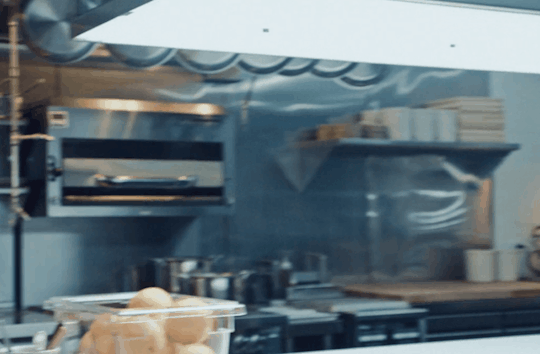
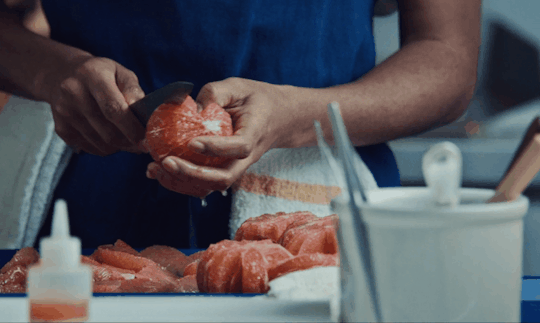
What are the odds of a parallel between knives and boxes, and it's only Carmy and Sydney being frustrated by the tasks of cutting and breaking down boxes?
It's the symbolism of sexual frustration between them.
Textbook Sublimation
Another Freud concept is sublimation - this is defined as redirecting sexual desire into socially acceptable behaviors or new aims that are still related to the sexual impulse. (AKA Carmy wants a star, not just to beat Chef David- but what carmy truly wants sexually is to please Sydney)
Remember what Richie said about Carmy as he shouts at him and then Carmy looks at Sydney?
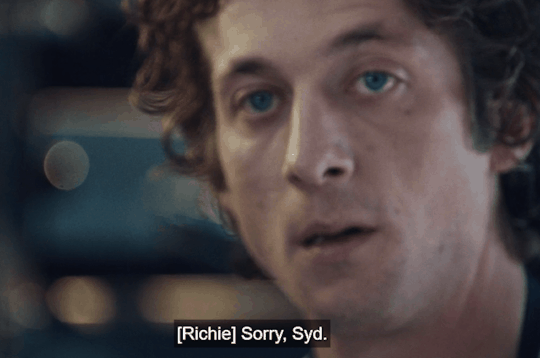
Let's definite what textbook sublimation is:
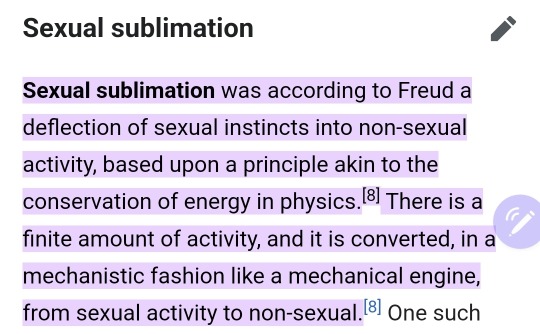
My theory is that Richie told Carmy that he sees him for who he really is. He knows Carmy and knows that he never wanted Claire in the first place. Richie is aware of the tension between Sydney and Carmy, and Carmy's been repressing it all along. Richie is very observant; look at how he observes the tension between Carmy and Sydney.
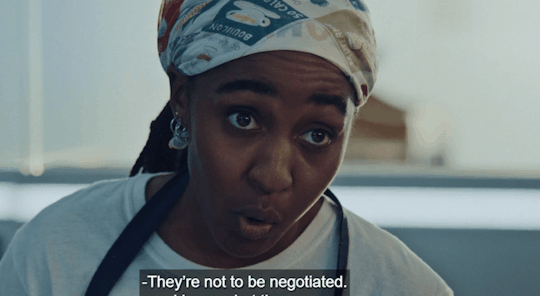
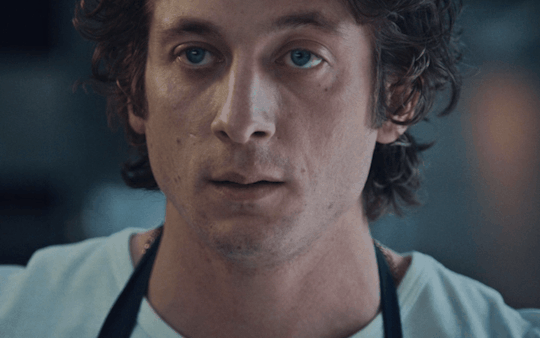
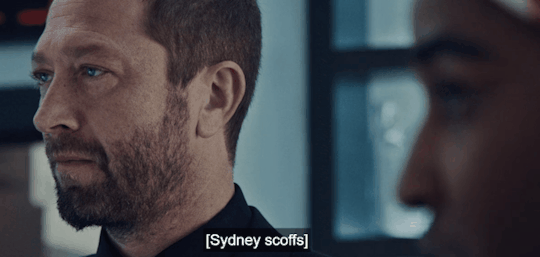

Bonus: Look how Carmy stares at Sydney- he could care less about the Faks in this moment. He's feeling bad for giving her a headache but he wants to fight some more.
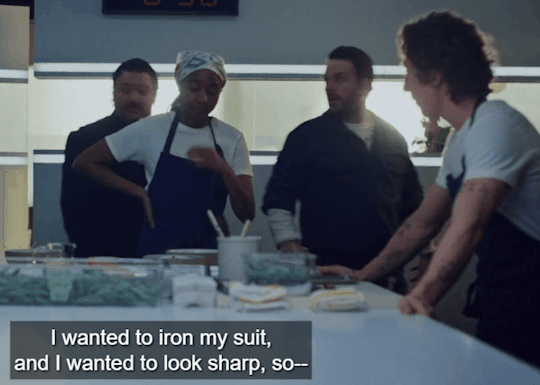
Remember, we theorize here that season 3 breaks into the fourth wall. At that moment, Richie is talking to the audience, giving us a rundown of why Carmy avoids and creates a prison in his mind. We didn't get a clear answer because we were inside Carmy's mind throughout the season. He was experiencing confusion, repression of his urges, and an inability to feel the pain he was going through. Another thing is that he could not accept any joy or love in his life.
I believe the decision to create a surrealist-style season is great because it complements Carmy's avant-garde food style, through which he communicates his artistic thoughts and feelings.
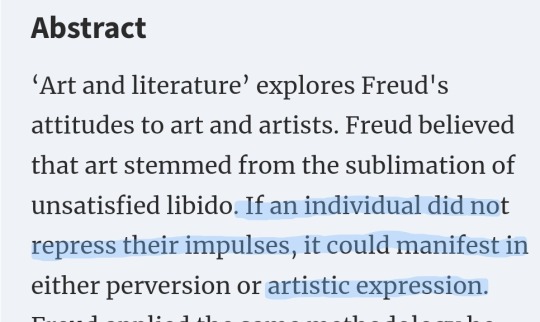
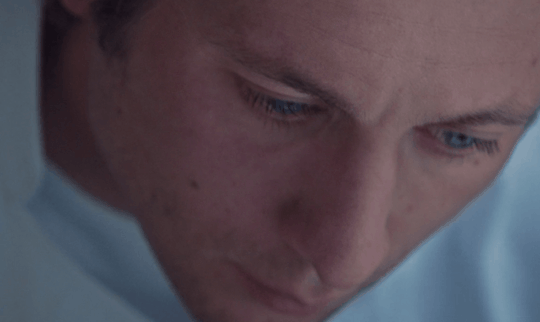

Through the image, we see that Carmy is in a dreamlike state, gazing at the dish he created unconsciously, which matches Sydney's scarf. This hits at the core truth of his desires that he does not want to address. Sydney is the real fun, joy, and amusement that can happen, but he's been sabotaging and repressing since day one, even with the choice of dating Claire. Carmy is more addicted to adrenaline, stress, chaos, and guilt.
I believe the bear in his dream symbolizes the Carmy's unconscious and repressed feelings - desires, guilt, and longing. These emotions overwhelm him as he returns home and processes his grief. The phrase "let it rip" carries multiple meanings, but in this case, I interpret it as a call for him to embrace his emotions and be true to himself.
Thank you for reading.
#sydcarmy#im not a doctor i just love film and psychoanalysis#long post but fun to write hopefully fun to read#i really appreciate sydcarmies! thank you for reading my thoughts#carmy x sydney
164 notes
·
View notes
Note
just wanted to say, as a fellow artist, THANK YOU for talking about shortcuts 🙏🙏 ive had baggage over not doing art """properly""" (re: the repetitive frustrating way just to prove i can), and im finally letting myself use tricks like warping and textured brushes and such, but i still feel weird sometimes. then i see a batshit amazing artist like you uses them, and i feel better. so thanks 😭 (and yes aye-eye is not included in this, mass theft isnt a shortcut)
The great thing about baggage is you can and absolutely should work up to just checking that crap in at the front desk and then conveniently forget to ever pick it back up~ Seriously though, it's no problem, and I'm glad to hear you're loosening up with it! If it helps, shortcuts are drilled into you if you work professionally in art. The only people who don't use shortcuts who work professionally are people who simply don't want to (be it stubbornly or out of enjoyment) and people who can afford to (names so big that deadlines will either be lenient or are dictated by the artist themself) The urgency to do everything the painstakingly hard way is, weirdly enough, a mindset most common in hobbyist spaces. People who want to do it that way (out of enjoyment, out of pride) are more than welcome to do it (as I'll sometimes just do slow crosshatching, no special brushes, because I find it relaxing)... but those who insist others do it or they aren't a real artist are often speaking from a position of bad faith, or are repeating what they had drilled into them by another hobbyist or their childhood/teen year art teachers, *or* are doing it to place themselves on a pedestal competitively. So, basically! Do things manually if you feel like it, but also know that there's hardly a "pro" out there that doesn't utilize a lot of fun little tricks and shortcuts. We still do it by our artistry, which is where the line is drawn with generated bullshit (also, you know, it's theft), but I guess a good way to look at it is like this: When you're drawing a piece of storytelling art or a comic page and the character has an elaborate costume with chains (my own character's lapel pins... we can look at Spawn, or a Nomura character and their department store of belts)...What's more important? The intricate detail of the chain, proving you can do it (again and again and again, since every angle would need to be drawn anew) Or the character acting, the composition, the atmosphere? It's the aspects that tell something about the character, the action, and the story that are always going to win out and matter, meaning that chain is just busy work-- a prime candidate for a quick swipe of a chain brush, or if you're me, this little friend:

So, yeah!! At the end of the day, the most important thing is to do what brings you joy or what meets your goal. I do love drawing clothes and I love details (love patterns and gold details especially)... but I also love finishing my work and shortcuts allow me to focus on the charcter acting and the atmosphere instead! Go forth and don't feel guilty. So long as you're not stealing from anyone and having fun, you're not doing anything wrong.
80 notes
·
View notes
Text
Hey so S2E9 'Three Stroires' was fucking bonkers
LETS TALK ABOUT IT
The episode is DENSE AS ALL HELL with things to talk about, the three main things being
The titles
The art style and style of storytelling
The dialogue (or lack thereof)
Lets speedrun some analysis notes of our three favourite members of the worst found family ever!!









Storytelling Styles
All three stories are emotionally driven and told in dramatic styles without realism, though all for differing reasons.
QJ mimics the over-the-top Shakespearean reminiscent of his wife, believing himself to be the main character of a tragedy. Though this style of story telling is obviously campy and corny, it's also presented in a way where it's not immediately clear to the viewers that this isn't actually real -- it's a fabrication of the canon within the canon as a reflection of QJ's delusions.
LTC mimics QJ, however, his disposition leads to him seeing everything as a Greek Comedy as opposed to perma-victim QJ's Greek Tragedy. It also reflects LTC ultimately leaning into and revelling in killing other people as part of his hunter ethos and evolution. LTC's style does not need to be realistic because LTC isn't looking for meaning in his story, but for an experience that's enjoyable and satisfying.
QJ and LTC's style complement each other with both being able to come together to tell a more cohesive narrative overall, although each does so by focusing on themselves more than anyone else.
LTX is a silent cartoon telling of her life story, quite literally the story that's gone untold, bar the words of the gossiping crows (people with frivolous and passing interest in her life writing their own stories about the events she goes through). Her story telling style is a reflection of her mindset and being trapped cognitively as a child for all time, and is further indication that her personhood wasn't allowed to independently grow since becoming an orphan.
LTX's story is outside of QJ and LTC's narrative because she cannot speak, and thus her story does not matter. No dramatisation of reality to paint a certain picture is needed, nor is her story seen or understood in either of theirs. Her story is insular and disconnected from theirs because her personhood is disconnected from theirs.
LTX's story is told through the lens of LTC and LX's worldview: that the world is made up of beasts and hunters. There is only ever one human character (likely LX himself rather than QJ, based on how visually loyal everyone else's designs are) while LTX watches LTC straddle the line between animal (his nature) and human (his will).
Story Titles
QJ's part being called the "Inevitable Tragedy" is a reference to how he is the creator of his own misfortune as it was never based in reality but his own unchecked paranoia.
LTC's part is called the Fortuitous Comedy is because it was fortuitous for QJ to find out about the twins' powers before anyone else via Tianchen's confession and subsequent laughter. It could also be due to LTC reaching his perceived hunter-status by the fortuitous case of Deng being Liu Min's first requested kill (for the same reason LTC hates Deng, no less).
LTX's title being the "Sibling's Fairy Tale" is rather self explanatory, much like the character herself if you took the damn time to talk to her. It's childish, stuck in the past (trauma), focused on her brother and the other light of her life: their late-mother. Another piece of insight that I remembered hearing is that fairy tales don't always have happy endings, but they always have a moral to learn from. In this sense, Xixi's story is thematically the most important because no character has put that moral into practice (confronting the worst aspects of those you love, refusing to look away from the secrets they hide while you stay in a peaceful dream with their softness).
Additional Notes
QJ caring for the twins in Part II is a reflection of LTC being gaslit about reality (reinforced by QJ's fatherly love being absent in LTX's story), as well as a reflection of his sense of self and human autonomy only beginning and flourishing due to the circumstances QJ provided
LTX's story suggests that most of the time she spends with LTC involves her napping in some form, or that most of her time in general was slept away as if she was trapped in some strange dream.
The only betrayal even hinted at is LTC's betrayal of LTX's morality, a twist that literally shatters LTX's childlike world and forces her hurdling into reality. This is the only betrayal because the twins are the only two who have trust in one another among the three.
Someone else made a point about how even when the foxboy picks up the bow and arrow, he remains a fox. In LTX's eyes, her brother can act as a hunter but he's still a beast and that's not a bad thing.
The fact that most people are 'beasts' and there's only one human in all of LTX's worldview really is some solid symbolism and messaging, especially considering LTX is socially classified as an undesirable a la her disabilities. It's peak reclamation and pride in Oneself.
#link click#link click season 2#link click spoilers#link click analysis#shiguang dailiren#qian jin#li tianchen#li tianxi#li tian twins#LAN went hard with this one#they cooked
186 notes
·
View notes